Abstract
We demonstrate a triple-wavelength thulium-doped fiber random laser using a 10 cm long random fiber grating to provide random distributed feedback and a superimposed fiber Bragg grating as the wavelength-selective mirror. The random fiber grating inscribed in single-mode fibers using a femtosecond laser provides strong random distributed feedback that avoids the use of long distance fibers and leads to a relatively low threshold power. Triple-wavelength random laser output at wavelengths of 1943.6, 1945.0 and 1946.3 nm was achieved with a relatively low threshold power of 2.01 W, a slope efficiency of 7.86% and a maximum output power of 151.8 mW when it was pumped using a 793 nm laser diode. The 3 dB linewidth was less than 0.1 nm and the optical signal-to-noise ratio was up to 45.6 dB. Good wavelength stability was achieved, which was attributed to the narrow band and stable reflection of the superimposed fiber Bragg grating. The time-domain characteristics of the laser output were also measured and analyzed, and some random self-pulsing caused by relaxation oscillations were observed.
1. Introduction
Random fiber lasers (RFLs) have been extensively investigated in the past decade for their unique features of random lasing and potential applications in several areas including fiber sensing, fiber communications, speckle-free imaging, etc. [1,2,3,4,5]. To build a RFL, random distributed feedback is the most important technology that in most of the reported RFLs is based on the random distributed backward Rayleigh scattering in a long optical fiber [6,7,8,9]. To get the optical signal amplified, stimulated Raman [10,11] or Brillouin [12,13,14] scattering effects or other gain mechanisms [15,16] in optical fibers are usually used. However, due to the small coefficient of Rayleigh scattering in optical fibers, the length of the fiber required may be up to tens of kilometers which introduces relatively large transmission loss and high cost [7,8,10,11,12,15,16]. Specially designed optical fiber gratings or grating arrays have been developed to shorten the fiber length of RFLs and suppress the threshold power by providing random distributed feedback with a much higher efficiency [17,18,19,20,21,22].
Fiber lasers operating at a 2 μm wavelength band have attracted lots of research interest in recent years. They possess many advantages including an eye-safe laser wavelength and low atmospheric transmission loss, showing great potential for many fields such as medical surgery, lidar, free-space optical communication, remote sensing, gas detection, etc. [23,24,25,26,27]. To achieve RFLs at a 2 μm region, thulium-doped fibers (TDFs) or highly GeO2-doped silica fibers were used as the gain medium, and the random feedback mechanism was usually Rayleigh scattering in long single-mode fibers (SMFs) or ultra-high numerical aperture passive fibers [28,29,30]. Compared with the commonly used SMFs, the highly GeO2-doped silica fibers have relatively low transmission loss and high Raman gain coefficient in the 2 µm wavelength band [31,32,33]. However, the weak Rayleigh scattering in these fibers still caused long fiber length and high pump threshold in the reported 2 μm RFLs. Moreover, these studies mainly focused on single wavelength lasing and multi-wavelength lasing was rarely studied.
In this work, we demonstrate a triple-wavelength TDF random laser using a 10 cm long random fiber grating (RFG) to provide the random distributed feedback and a superimposed fiber Bragg grating (SFBG) as the wavelength-selective mirror. A triple-wavelength random laser output with a 3 dB linewidth less than 0.1 nm and optical signal-to-noise ratio (OSNR) up to 45.6 dB was obtained under the pump of a 793 nm laser diode. The threshold pump power was 2.01 W and the maximum output power reached 151.8 mW with a slope efficiency of 7.86%. The time-domain characteristics of the laser output were also studied.
2. Experimental Setup
A schematic diagram of the proposed triple-wavelength TDF random laser is shown in Figure 1. A 1.2 m-long double-cladding TDF (Nufern, SM-TDF-10P/130-HE) was pumped by a 793 nm laser diode (LD) through a 793/2000 nm wavelength division multiplexer (WDM). The RFG was fusion spliced to the signal port of the WDM to provide random distributed feedback and the SFBG was connected to the end of the TDF to reflect the selected wavelengths. The laser output was guided out from the left end of the RFG. Both ends of the RFL fibers were fusion spliced to angle-polished connectors to avoid Fresnel reflections from the fiber ends. The mode field diameter, numerical aperture and the absorption coefficient at 793 nm of the TDF were 10 μm, 0.15 and 3.6 dB/m, respectively.
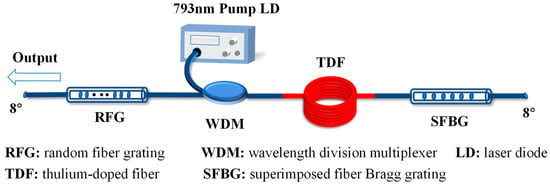
Figure 1.
Experimental setup of the triple-wavelength TDF random laser.
The RFG used in this work was 10 cm long with ~6000 randomly spaced refractive index modulation points, which were inscribed point-by-point in a SMF along the length of the fiber using a Ti:Sapphire laser operating at 800 nm with a repetition frequency of 100 Hz and pulse duration of 80 fs [22]. The modulation points enhance the non-uniformity of the refractive index and lead to strong backward Rayleigh scattering in the SMF [34]. Figure 2 shows the measured reflection and transmission spectra of the RFG. Since the grating period was randomly distributed, there was no obvious reflection peak or transmission dip observed, except for several absorption lines of water molecules that could not be removed from the measurement. The measured power level of the reflection spectrum was ~5.2 dB higher than that of the transmission one because it was amplified before measurement. The power level before amplification was too low due to the relatively low level of the source power and the high insertion losses of the RFG, 5.3 ± 0.2 dB, and fusion splice points, ~2 dB, in the range of 1940 to 1950 nm.
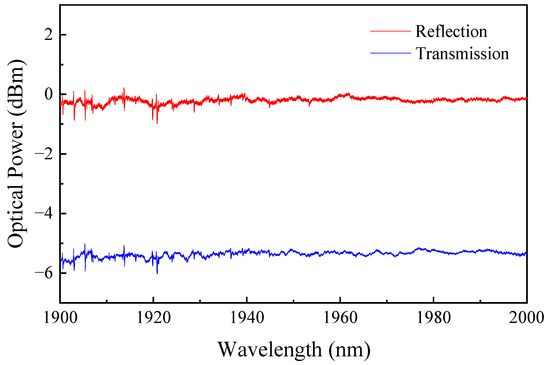
Figure 2.
Reflection and transmission spectra of the random fiber grating.
The SFBG with the transmission spectrum shown in Figure 3 contains three reflection peaks at wavelengths of 1943.6, 1945.0 and 1946.3 nm with different reflectivities of 90%, 87% and 79%, and 3 dB bandwidths of 0.27, 0.28 and 0.25 nm, respectively. The SFBG was fabricated by inscribing fiber Bragg gratings three times at the same fiber location through the same phase mask but applying three different stretching forces. The stretching forces generated different strains on the fiber during the three grating inscription processes so different reflection wavelengths were achieved after the stretching forces were released. The output spectrum of the RFL was measured using an optical spectrum analyzer (OSA, AQ6376, Yokogawa, Japan) with a wavelength resolution of 0.1 nm. The output power was monitored with an optical power meter (OPM, PM320E, Thorlabs, Newton, NJ, USA) and the time-domain characteristics of the laser output were measured using a 25 MHz photodetector (PD, PDA10D2, Thorlabs, Newton, NJ, USA) and an oscilloscope (OSC, MSO8204, Rigol, China).
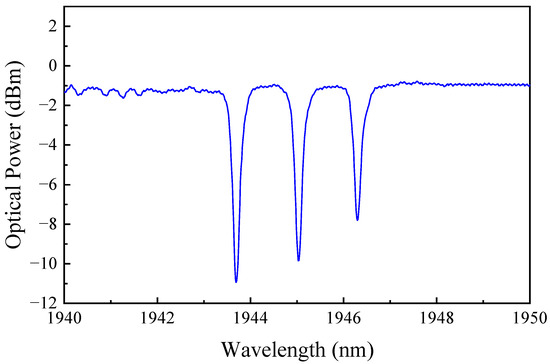
Figure 3.
Transmission spectrum of the superimposed fiber Bragg grating.
3. Experimental Results and Discussion
We increased the pump power gradually from zero and observed the output spectrum of the RFL. Figure 4 shows the evolution of the emission spectra recorded at different pump powers and Figure 5 shows the power variations of the three lasing peaks with pump power. When the pump power was below 2.01 W, no random lasing was observed but only the SFBG reflected amplified spontaneous emission peaks of the three FBGs that increased linearly with pump power. When the pump power reached 2.01 W, lasing started from the generation of stochastic pulses with amplitudes higher than the quasi-stationary background. Several discrete narrow spikes with different peak intensities were observed at around 1946.3 nm, resulting in a large increase in the peak power. With further increasing pump power, the stochastic narrowband components were broadened and superposed gradually. They finally merged into a single smooth and stable narrowband laser output.
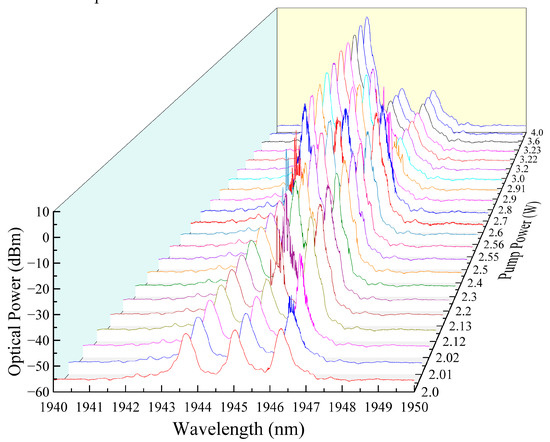
Figure 4.
Output spectra of the RFL measured at various pump powers.
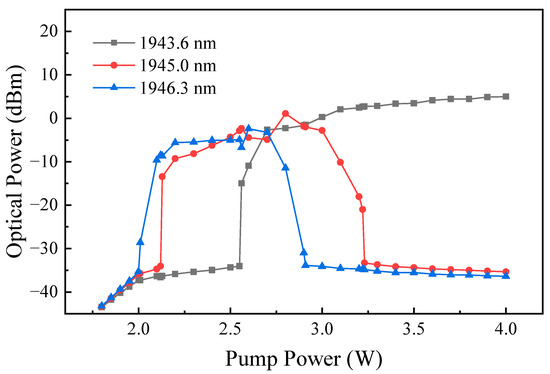
Figure 5.
Power variations of the three lasing peaks with pump power.
Some discrete random narrow spikes appeared at around 1945.0 nm and then at around 1943.6 nm when the pump power was increased to 2.13 and 2.56 W, respectively. Their evolutions with increasing pump power were the same as those generated at the first lasing peak of 1946.3 nm. They were gradually broadened and superposed to form two relatively stable and smooth peaks at higher pump powers. At the same time, the optical power of the formed smooth laser peak increased gradually with pump power. When the pump power reached 2.7 W, the three lasing peaks were observed simultaneously at 1943.6, 1945.0 and 1946.3 nm, respectively. The measured laser spectrum is shown in Figure 6. The 3 dB linewidths were 0.081, 0.099, and 0.083 nm, respectively, and the OSNRs for the lasing peaks were 45.6, 43.3 and 44.9 dB, respectively.
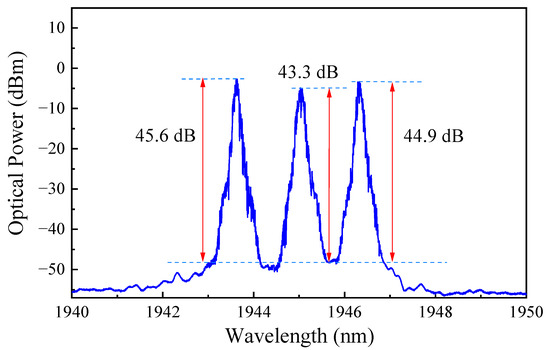
Figure 6.
Output spectrum of the RFL at pump power of 2.7 W.
When the pump power was further increased, the intensity of the laser peak at 1946.3 nm started to decrease, while the intensity of the other two peaks at 1943.6 and 1945.0 nm kept increasing. The laser peak at 1945.0 nm reached the maximum intensity at a pump power of 2.8 W. Conversely, the output lasing peak at 1946.3 nm became quite low and separated into several random narrow spikes at a pump power of 2.9 W. The spikes disappeared when the pump power was further increased to 2.91 W, leaving only the smooth reflection peak of the SFBG at 1946.3 nm. When the pump power was increased further, the laser peak at 1945.0 nm gradually decreased and then separated into narrow spikes, and disappeared when the pump power increased to 3.23 W. Only the lasing peak at the shortest wavelength of 1943.6 nm continued to grow when the pump power was increased from 3.23 W to 4.0 W. The other two peaks shrank during this phase.
The emergence and instability of the discrete random narrow spikes at different lasing peaks were mainly caused by the cooperative stimulated Brillouin backward scattering and Rayleigh backward scattering processes, as well as by the gain competition between different lasing modes including both the localized and extended modes [35,36,37,38]. The output spectrum gradually became stable and smooth with the increase in pump power. This might arise from spectrum broadening caused by nonlinear optical effects, such as four-wave mixing, self-phase and cross-phase modulation, etc., in the fiber [39,40]. The order of generation and changes in intensity of the three lasing peaks in the evolution of the laser spectrum were caused by wavelength variations of the gain peak of the TDF with pump power [41,42]. When the pump power was low, the TDF gave the maximum gain at the long wavelength side of the three reflection peaks of the SFBG, so the emission generated first at the longest wavelength peak. The peak gain wavelength shifted towards the short wavelength direction with pump power, thus the intermediate and the shortest wavelength peaks started to emit in turn at relatively higher pump powers. When the pump power was further increased and the gain peak of the TDF was sufficiently shifted to the short wavelength side, the laser emission became weak from the longest wavelength peak in turn and then stopped.
Figure 7 shows the measured laser output power vs. pump power. It can be seen that the output power increased linearly with the pump power once it exceeded the threshold of 2.01 W. The laser achieved a maximum output power of 151.8 mW at a pump power of 4.0 W. The slope efficiency was 7.86%. Compared with the previously reported TDF random laser using a 200 m-long SMF as the random distributed feedback media, our laser gave the close slope efficiency but much lower threshold power, ~57% of that in [29].
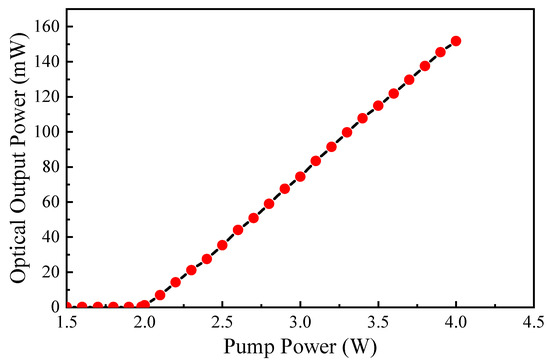
Figure 7.
Optical output power of the RFL vs. pump power.
To test the stability of the triple-wavelength RFL achieved at a pump power of 2.7 W, we measured the RFL’s output spectra every 5 min using the OSA and recorded the laser output power once per second using the OPM within a one-hour period. Figure 8 and Figure 9 show the measured results for peak wavelengths and laser output power vs. time, respectively. It can be seen that the laser peak wavelengths were very stable with a maximum wavelength shift of 0.08 nm. The measured laser output power was 17.07 0.20 dBm.
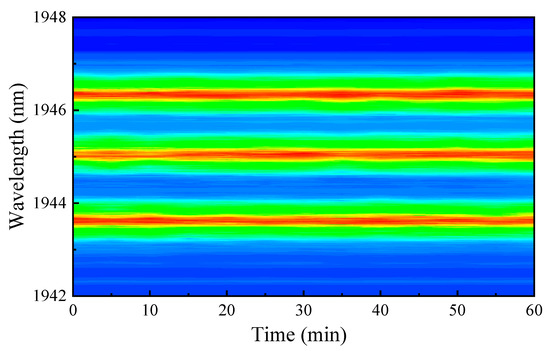
Figure 8.
Stability measurement results of the triple-wavelength RFL.
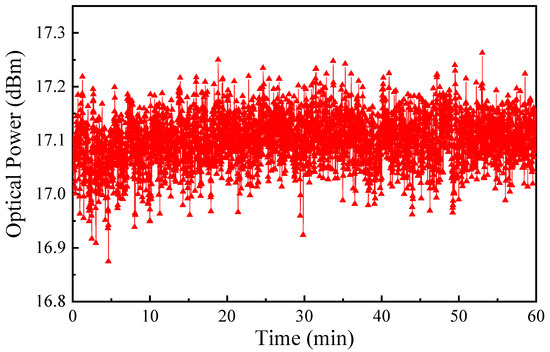
Figure 9.
Measured output power of the triple-wavelength RFL vs. time.
In order to investigate the temporal characteristics of the RFL lasing output, we recorded the time-domain traces using the 25 MHz photodetector and the oscilloscope and used the value of the std/mean (standard deviation divided by mean) to characterize the time dynamics. The measured results are shown in Figure 10. When the pump power exceeded the lasing threshold, many random self-pulsing phenomena with different peak intensities were observed with a std/mean value of 0.3740. The random self-pulsing phenomena with different intensities may be caused by relaxation oscillations and excited-state absorption of the active fiber under nonuniform pumping [43,44,45]. Under continuous pumping, the gain and the Q-value of the cavity were recurrently driven up and down by the stimulated Brillouin scattering process [28], and the peak amplitude and repetition rate of these random self-pulsing became larger with increasing pump power. The three insets I, II and III in Figure 10 show the Fourier transform spectra of the three time-domain traces. It can be seen that the dominant repetition rates were ~52, 119 and 162.5 kHz at pump powers of 2.3, 2.7 and 4 W, respectively, though the frequency components were complex. When the pump power was sufficient to indirectly saturate the level of absorption, a continuous train of pulses or oscillations generated by the saturation absorption could be dampened [46], thus only some periodic pulse clusters were observed in Figure 10b,c. The modulation rates were about 7 and 6 kHz in these two cases. The std/mean between the self-pulsing intensity became smaller when the pump power was 4.0 W compared to that of 2.7 W. This may also be related to the reduction in the number of lasing peaks as there must be a large number of spatially overlapping lasing modes in each laser peak.
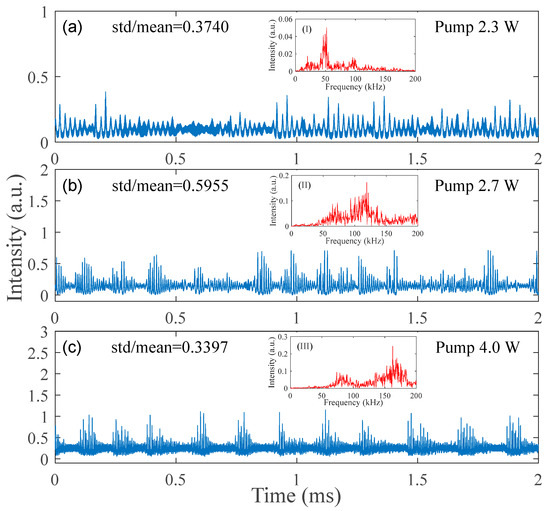
Figure 10.
Time-domain measurement results of the RFL output at different pump powers. (a) Pump power 2.3 W; (b) pump power 2.7 W; (c) pump power 4.0 W. The insets (I), (II) and (III) show the Fourier transform spectra of the corresponding time-domain traces.
4. Conclusions
A triple-wavelength TDF random laser has been demonstrated by using a femtosecond laser-inscribed random fiber grating to provide random distributed feedback and a superimposed fiber Bragg grating as the wavelength-selective mirror. A triple-wavelength random laser output with a 3 dB linewidth less than 0.1 nm and OSNR up to 45.6 dB was achieved using a 793 nm pump laser diode. The threshold pump power was 2.01 W and the maximum output power reached 151.8 mW with a slope efficiency of 7.86%. The random fiber grating was only 10 cm long but provided strong random distributed feedback, avoiding the use of long-distance feedback fibers in the random laser. The triple-wavelength random fiber laser showed good wavelength stability thanks to the stable narrow-band reflection of the superimposed fiber Bragg grating. The time-domain measurement results showed that the laser output contained lots of self-pulsing with nonuniform intensities and changeable repetition rate depending on pump power, which may have significant potential in producing self-switching mid-infrared laser pulses.
Author Contributions
Conceptualization, L.Z. and X.D.; methodology, X.D.; software, L.Z. and Y.H.; validation, L.Z.; formal analysis, L.Z., Y.H. and X.D.; investigation, P.X. and W.Z.; resources, Z.G. and X.D.; data curation, L.Z. and X.D.; writing—original draft preparation, L.Z.; writing—review and editing, X.D.; supervision, P.X. and Z.G.; project administration, X.D. All authors have read and agreed to the published version of the manuscript.
Funding
This research was funded by the National Key Research and Development Program of China (2020YFB1805804), National Natural Science Foundation of China (11974083) and the Program for Guangdong Introducing Innovative and Entrepreneurial Teams (2019ZT08X340).
Institutional Review Board Statement
Not applicable.
Informed Consent Statement
Not applicable.
Data Availability Statement
The data presented in this study are available upon request.
Conflicts of Interest
The authors declare no conflict of interest.
References
- Turitsyn, S.K.; Babin, S.A.; El-Taher, A.E.; Harper, P.; Churkin, D.V.; Kablukov, S.I.; Ania-Castañón, J.D.; Karalekas, V.; Podivilov, E.V. Random distributed feedback fibre laser. Nat. Photon. 2010, 4, 231–235. [Google Scholar] [CrossRef]
- Wang, Z.N.; Rao, Y.J.; Wu, H.; Li, P.Y.; Jia, X.H.; Zhang, W.L. Long-distance fiber-optic point-sensingsystems based on random fiber lasers. Opt. Express 2012, 20, 17695–17700. [Google Scholar] [CrossRef] [PubMed]
- Redding, B.; Choma, M.A.; Cao, H. Speckle-free laser imaging using random laser illumination. Nat. Photon. 2012, 6, 355–359. [Google Scholar] [CrossRef]
- De Matos, C.J.S.; Menezes, L.D.S.; Brito-Silva, A.M.; Gamez, M.A.M.; Gomes, A.S.L.; Araujo, C.B.D. Random fiber laser. Phys. Rev. Lett. 2007, 99, 153903. [Google Scholar] [CrossRef] [PubMed]
- Gomes, A.S.L.; Moura, A.L.; de Araújo, C.B.; Raposo, E.P. Recent advances and applications of random lasers and random fiber lasers. Prog. Quantum Electron. 2021, 78, 100343. [Google Scholar] [CrossRef]
- Quan, X.; Ma, R.; Wu, H.; Bai, Z.Y.; Fan, D.Y.; Liu, J. Low threshold and high spectral purity 1.7 μm random fiber laser based on hybrid gain. Opt. Laser Technol. 2022, 155, 108410. [Google Scholar] [CrossRef]
- Wang, L.L.; Dong, X.Y.; Shum, P.P.; Su, H. Tunable erbium-doped fiber laser based on random distributed feedback. IEEE Photon. J. 2014, 6, 1501705. [Google Scholar]
- Aporta, I.; Perez-Herrera, R.A.; Quintela, M.A.; Lopez-Amo, M.; Lopez-Higuera, J.M. Tunable dual-wavelength random distributed feedback fiber laser with bidirectional pumping source. J. Lightw. Technol. 2016, 34, 4148–4153. [Google Scholar] [CrossRef]
- Jagannathan, S.; Ackerman, L.; Chen, W.; Yu, N.; Cavillon, M.; Tuggle, M.; Hawkins, T.W.; Ballato, J.; Dragic, P.D. Random lasing from optical fibers with phase separated glass cores. Opt. Express 2020, 28, 22049–22063. [Google Scholar] [CrossRef] [PubMed]
- Sugavanam, S.; Zulkifli, M.Z.; Churkin, D.V. Multi-wavelength erbium/Raman gain based random distributed feedback fiber laser. Laser Phys. 2015, 26, 15101. [Google Scholar] [CrossRef]
- Zhang, Y.; Ye, J.; Ma, X.Y.; Xu, J.M.; Song, J.X.; Yao, T.F.; Zhou, P. High power tunable multiwavelength random fiber laser at 1.3 μm waveband. Opt. Express 2021, 29, 5516–5524. [Google Scholar] [CrossRef] [PubMed]
- Zhang, L.; Xu, Y.P.; Gao, S.; Saxena, B.; Chen, L.; Bao, X.Y. Multiwavelength coherent Brillouin random fiber laser with ultrahigh optical signal-to-noise ratio. IEEE J. Sel. Top. Quantum Electron. 2017, 24, 0900308. [Google Scholar] [CrossRef]
- Tehranch, A.; Iezzi, V.L.; Kashyap, R. Power fluctuations and random lasing in multiwavelength Brillouin erbium-doped fiber lasers. J. Lightw. Technol. 2019, 37, 4439–4444. [Google Scholar] [CrossRef]
- Zhou, Z.C.; Chen, L.; Bao, X.Y. High efficiency Brillouin random fiber laser with replica symmetry breaking enabled by random fiber grating. Opt. Express 2021, 29, 6532–6541. [Google Scholar] [CrossRef] [PubMed]
- Huang, C.Q.; Dong, X.Y.; Zhang, N.; Zhang, S.Y.; Shum, P.P. Multiwavelength Brillouin-Erbium random fiber laser incorporating a chirped fiber Bragg grating. IEEE J. Sel. Top. Quantum Electron. 2014, 20, 294–298. [Google Scholar] [CrossRef]
- Saleh, S.; Cholan, N.A.; Sulaiman, A.H.; Mahdi, M.A. Stable multiwavelength erbium-doped random fiber laser. IEEE J. Sel. Top. Quantum Electron. 2017, 24, 0902106. [Google Scholar] [CrossRef]
- Wang, L.L.; Dong, X.Y.; Shum, P.P.; Liu, X.H.; Su, H.B. Random laser with multiphase-shifted Bragg grating in Er/Yb-codoped fiber. J. Lightw. Technol. 2015, 33, 95–99. [Google Scholar] [CrossRef]
- Zhang, A.L.; Hao, L.Y.; Geng, B.; Li, D. Investigation of narrow band random fiber ring laser based on random phase-shift Bragg grating. Opt. Laser Technol. 2019, 116, 1–6. [Google Scholar] [CrossRef]
- Miao, S.J.; Zhang, W.T.; Song, Y. Random Bragg-gratings-based narrow linewidth random fiber laser with a π-phase-shifted FBG. Chin. Opt. Lett. 2019, 17, 090605. [Google Scholar] [CrossRef]
- Popov, S.M.; Butov, O.V.; Bazakutsa, A.P.; Vyatkin, M.Y.; Chamorovskii, Y.K.; Fotiadi, A.A. Random lasing in a short Er-doped artificial Rayleigh fiber. Results Phys. 2020, 16, 102868. [Google Scholar] [CrossRef]
- Gagné, M.; Kashyap, R. Random fiber Bragg grating Raman fiber laser. Opt. Lett. 2014, 39, 2755–2758. [Google Scholar] [CrossRef] [PubMed]
- Li, Y.; Lu, P.; Baset, F.; Ou, Z.Y.; Song, J.; Alshehri, A.; Bhardwaj, V.R.; Bao, X.Y. Narrow linewidth low frequency noise Er-doped fiber ring laser based on femtosecond laser induced random feedback. Appl. Phys. Lett. 2014, 105, 101105. [Google Scholar] [CrossRef]
- Pierce, M.C.; Jackson, S.D.; Dickinson, M.R.; King, T.A. Laser-tissue interaction with a high-power 2-μm fiber laser: Preliminary studies with soft tissue. Las. Surg. Med. 1999, 25, 407–413. [Google Scholar] [CrossRef]
- Tendean, M.; Mambu, T.D.B.; Tjandra, F.; Panelewen, J. The use of thulium-doped fiber laser (TDFL) 1940 nm as an energy device in liver parenchyma resection, a-pilot-study in Indonesia. Ann. Med. Surg. 2020, 60, 491–497. [Google Scholar] [CrossRef] [PubMed]
- Ahmad, N.A.; Dahlan, S.H.; Cholan, N.A.; Ahmad, H.; Amiri, I.S.; Tiu, Z.C. Dual-wavelength thulium fluoride fiber laser based on SMF-TMSIF-SMF interferometer as potential source for microwave generation in 100-GHz region. IEEE J. Sel. Top. Quantum Electron. 2018, 54, 1600207. [Google Scholar] [CrossRef]
- Taczak, T.M.; Killinger, D.K. Development of a tunable, narrow-linewidth, cw 2.066-μm Ho:YLF laser for remote sensing of atmospheric CO2 and H2O. Appl. Opt. 1998, 37, 8460–8476. [Google Scholar] [CrossRef]
- Churkin, D.V.; Sugavanam, S.; Vatnik, I.D.; Wang, Z.N.; Podivilov, E.V.; Babin, S.A.; Rao, Y.J.; Turitsyn, S.K. Recent advances in fundamentals and applications of random fiber lasers. Adv. Opt. Photon. 2015, 7, 516–569. [Google Scholar] [CrossRef]
- Tang, Y.L.; Xu, J.Q. A random Q-switched fiber laser. Sci. Rep. 2015, 5, 9338. [Google Scholar] [CrossRef]
- Ma, R.; Liu, J.; Fang, Z.Q.; Fan, D.Y. Mid-infrared random fiber laser assisted by the passive feedback. J. Lightw. Technol. 2021, 39, 5089–5095. [Google Scholar] [CrossRef]
- Jin, X.X.; Lou, Z.K.; Zhang, H.W.; Xu, J.M.; Zhou, P.; Liu, Z.J. Random distributed feedback fiber laser at 2.1 μm. Opt. Lett. 2016, 41, 4923–4926. [Google Scholar] [CrossRef]
- Cumberland, B.A.; Popov, S.V.; Taylor, J.R.; Medvedkov, O.I.; Vasiliev, S.A.; Dianov, E.M. 2.1 μm continuous-wave Raman laser in GeO2 fiber. Opt. Lett. 2007, 32, 1848–1850. [Google Scholar] [CrossRef] [PubMed]
- Jiang, H.W.; Zhang, L.; Feng, Y. Silica-based fiber Raman laser at >2.4 μm. Opt. Lett. 2015, 40, 3249–3252. [Google Scholar] [CrossRef] [PubMed]
- Dianov, E.M.; Bufetov, I.A.; Mashinsky, V.M.; Neustruev, V.B.; Medvedkov, O.I.; Shubin, A.V.; Melkumov, M.A.; GurYanov, A.N.; Khopin, V.F.; Yashkov, M.V. Raman fibre lasers emitting at a wavelength above 2 μm. Quant. Electron. 2004, 34, 695–697. [Google Scholar] [CrossRef]
- Skvortsov, M.I.; Wolf, A.A.; Dostovalov, A.V.; Egorova, O.N.; Semjonov, S.L.; Babin, S.A. Narrow-linewidth Er-doped fiber lasers with random distributed feedback provided by artificial rayleigh scattering. J. Lightw. Technol. 2022, 40, 1829–1835. [Google Scholar] [CrossRef]
- Ravet, G.; Fotiadi, A.A.; Blondel, M.; Megret, P. Passive Q-switching in all-fibre Raman laser with distributed Rayleigh feedback. Electron. Lett. 2004, 40, 528–529. [Google Scholar] [CrossRef]
- Fotiadi, A.A.; Kiyan, R.V. Cooperative stimulated Brillouin and Rayleigh backscattering process in optical fiber. Opt. Lett. 1998, 23, 1805–1807. [Google Scholar] [CrossRef]
- Zhang, W.L.; Li, S.W.; Ma, R.; Rao, Y.J.; Zhu, Y.Y.; Wang, Z.N.; Jia, X.H.; Li, J. Random distributed feedback fiber laser based on combination of Er-doped fiber and single-mode fiber. IEEE J. Sel. Top. Quantum Electron. 2015, 21, 0900406. [Google Scholar]
- Fallert, J.; Dietz, R.J.B.; Sartor, J.; Schneider, D.; Klingshirn, C.; Kalt, H. Co-existence of strongly and weakly localized random laser modes. Nat. Photon. 2009, 3, 279–282. [Google Scholar] [CrossRef]
- Fotiadi, A.A. An incoherent fiber laser. Nat. Photon. 2010, 4, 204–205. [Google Scholar] [CrossRef]
- Peng, M.; Bao, X.Y.; Chen, L. Observation of narrow linewidth spikes in the coherent Brillouin random fiber laser. Opt. Lett. 2013, 38, 1866–1868. [Google Scholar] [CrossRef]
- Yang, J.L.; Zhong, H.Z.; Zhang, S.Y.; Fan, D.Y. Theoretical characterization of the ultra-broadband gain spectra at ∼1600–2100 nm from thulium-doped fiber amplifiers. IEEE Photon. J. 2016, 8, 1400310. [Google Scholar] [CrossRef]
- Li, Z.; Jung, Y.; Daniel, J.M.O.; Simakov, N.; Tokurakawa, M.; Shardlow, P.C.; Jain, D.; Sahu, J.K.; Heidt, A.M.; Clarkson, W.A.; et al. Exploiting the short wavelength gain of silica-based thulium-doped fiber amplifiers. Opt. Lett. 2016, 41, 2197–2200. [Google Scholar] [CrossRef]
- Upadhyaya, B.N.; Kuruvilla, A.; Chakravarty, U.; Shenoy, M.R.; Thyagarajan, K.; Oak, S.M. Effect of laser linewidth and fiber length on self-pulsing dynamics and output stabilization of single-mode Yb-doped double-clad fiber laser. Appl. Opt. 2010, 49, 2316–2325. [Google Scholar] [CrossRef] [PubMed]
- Tang, Y.L.; Xu, J.Q. Effects of excited-state absorption on self-pulsing in Tm3+-doped fiber lasers. J. Opt. Soc. Am. B 2010, 27, 179–186. [Google Scholar] [CrossRef]
- Jackson, S.D.; King, T.A. Dynamics of the output of heavily Tm-doped double-clad silica fiber lasers. J. Opt. Soc. Am. B 1999, 16, 2178–2188. [Google Scholar] [CrossRef]
- Marcuse, D. Pulsing behavior of a three-level laser with saturable absorber. IEEE J. Quantum Electron. 1993, 29, 2390–2396. [Google Scholar] [CrossRef]
Disclaimer/Publisher’s Note: The statements, opinions and data contained in all publications are solely those of the individual author(s) and contributor(s) and not of MDPI and/or the editor(s). MDPI and/or the editor(s) disclaim responsibility for any injury to people or property resulting from any ideas, methods, instructions or products referred to in the content. |
© 2023 by the authors. Licensee MDPI, Basel, Switzerland. This article is an open access article distributed under the terms and conditions of the Creative Commons Attribution (CC BY) license (https://creativecommons.org/licenses/by/4.0/).